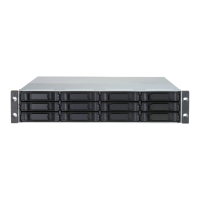VessRAID 1000i Series Product Manual
70
5. Enter a value in the field for each of the following items:
• Node Name – An iSCSI node is identified by its name.
• Node Alias – Optional. Maximum of 31 characters. Use letters,
numbers, space between words and underscore.
• Max Burst Length – Maximum length of a solicited data sequence
(512 b to 16 Mb).
• Default Time to Wait – After a dropped connection, the number of
seconds to wait before attempting to reconnect.
• Default Time to Retain – Number of seconds after time to wait (above)
before reassigning outstanding commands.
6. Check the corresponding box to enable the following features:
• Enable Header Digest – Enables use of Header Digest (CRC). See note
below.
• Enable Data Digest – Enables use of a Data Digest (CRC). See note
below.
• Enable Uni-directional CHAP Authentication – Enables Challenge
Handshake Authentication Protocol
• Enable Bi-directional CHAP Authentication
7. Click the Submit button.
Viewing iSCSI Target Ports
You can see the target port settings, but none of these values are user-adjustable
in the current version of the software.
To view the iSCSI target port settings:
1. Click the Subsystem icon in Tree View.
2. Click the Administrative Tools icon.
3. Click the iSCSI Management icon.
4. Click the Target Ports tab in Management View.
Notes
• Header Digest and Data Digest work best with initiators
equipped with a TCP Offload Engine (TOE). Refer to your
iSCSI HBA user manual for more information.
• For iSCSI network settings on the Data Ports, see “Making
iSCSI Port Settings” on page 67.
• For CHAPs, see “Working with iSCSI CHAPs” on page 73.

